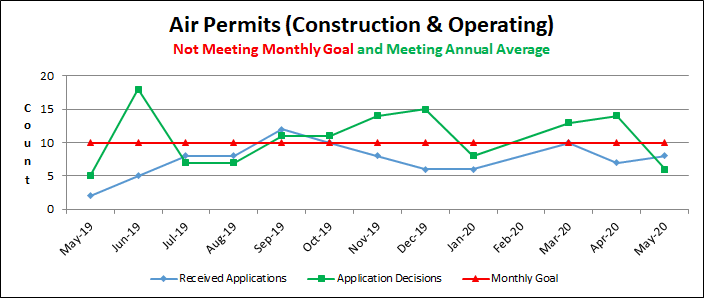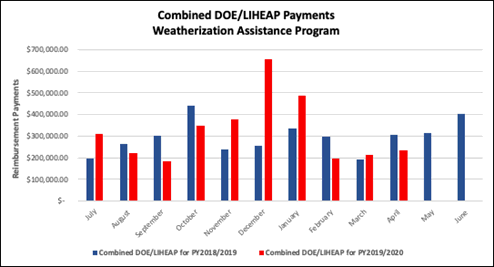May 2020 Metrics Report








| LOW INTEREST DOLLAR & ENERGY SAVINGS LOAN PROGRAM | ||||
| Period Ending | Loans | Total Improve. Cost | Eligible Energy Efficiency Improve. | Energy Office Loan |
| Month ending 05/31/20 | 69 | $1,010,221 | $1,010,221 | $676,240 |
| Prior Month ending 04/30/20 | 0 | $0 | $0 | $0 |
| Quarter ending 06/30/20 | 69 | $1,010,221 | $1,010,221 | $676,240 |
| Fiscal Year ending 06/30/20 | 351 | $9,194,697 | $8,609,524 | $6,381,345 |
| Fiscal Year ending 6/30/19 | 317 | $12,357,673 | $11,736,699 | $7,739,115 |
| Total Energy Office Loans Outstanding May 31, 2020 | $36,303,188 | |||
| Total Energy Office Loans 1990 thru May 31, 2020 | $183,321,192 | |||
| LOW INCOME WEATHERIZATION ASSISTANCE PROGRAM | ||
| PAYMENTS | UNITS WEATHERIZED | ESTIMATED ANNUAL ENERGY SAVINGS |
| Monthly Reimbursements – April 2020* | (Based on $378/unit annual savings) | |
| $235,545.94 | 9 | $3,402/year |
| Monthly Reimbursements – March 2020* | ||
| $213,575.26 | 14 | $5,292 /year |
| Weatherization Projects Completed July 2019 – June 2020** (Ten months) | ||
| $3,231,101.80 | 277 | 104,706/year |
| Weatherization Projects Completed July 2018 – June 2019** | ||
| $3,547,261.91 | 444 | $167,832/year |
| * Reimbursements are made to community action agencies for projects completed prior month | ||
| ** Weatherization projects completed by community action agencies during the month(s) or year | ||
LIHEAP: Low Income Home Energy Assistance Program
DOE: Department of Energy
PY: Program Year (July 1 to June 30th)
Emerging Risks/Issues:
- Due to the impact of COVID-19 on operations, all 2020 waste grantees were offered an optional one-year extension if they are unable to hold their planned events (HHW disposal, e-waste disposal, scrap tire cleanup, roadside cleanups), or to conduct school or community presentations. They are to let us know by July 1 if they need an extension, and will need to provide a revised timeline.
Accomplishments:
- Because the COVID-19 pandemic has limited in-person gatherings, NDEE’s Onsite Section has begun administering individual Onsite Wastewater exams through video chat and Google Forms. Seven exams have already taken place, and three more are being scheduled. This online option has allowed the regulated community to maintain certification while protecting public health.
- The Energy and Assistance Division, with assistance from IT, provided a free five-part webinar series on the updated 2018 International Energy Conservation Code (IECC), which will become the Nebraska Energy Code on July 1. Attendance numbers — comprising members of local governments, Nebraska’s construction and design industry and the general public — totaled 562.
- NDEE began its weekly sampling of public beaches for Harmful Algal Blooms (HABs, also known as toxic algae) on May 18th. This year, the threshold for a state health alert has been changed from 20 ppb of the toxin microcystin to 8 ppb, based on new levels established by the Environmental Protection Agency. No health alerts have been issued to date.
Miscellaneous:
- NDEE and the State Fire Marshall conducted a coordination meeting for the purpose of examining issues of common interest. This was a proactive meeting focusing on a number of issues, and action plans were developed in an attempt to attain more effective inter-agency collaboration.